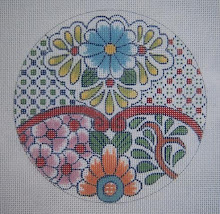 Blending filament again, and what a great find for a former dilemma! These Talavera pieces couldn't take decorative stitches, but definitely needed something to jazz them up a bit for use as tree ornaments - especially with the bright and lively colors.
Blending filament again, and what a great find for a former dilemma! These Talavera pieces couldn't take decorative stitches, but definitely needed something to jazz them up a bit for use as tree ornaments - especially with the bright and lively colors. This little cross is a smaller version of one I'm showing on Freebies, as an example of how to make the change in size for a simpler project. The description of how I use blending filament for the most effect is on this blog in an earlier post.
Anyway, I have really liked this one, but didn't want to undertake the big one right now, so had to "small it down" to stitch for myself.

I enjoy working on a bare canvas with only the outlines drawn - both because it's like painting with needle and thread, and because I'm too lazy to paint one for myself. It keeps me going to watch the pattern emerge in color!
I've started the outline on this one in Kreinik navy 018HL, size 12 braid (for 18 mesh canvas). It gives a bit of sparkle and shine along with the DMC cotton floss I've chosen.

The floss colors are exactly the colors on the cross, and the blending filament fits right in. I'm calling the navy, white, and orange the "background" on this piece, so won't use any sparkle with it - but the pattern elements definitely need the zing of some random sparkle and shine - hence the blending filament that won't overwhelm it as a shinier thread would.
By not making the background sparklle, the design will show up better. I'm off now to stitch a bit, as the weather turned cooler, and I can enjoy some fine, hot tea. (a new package has arrived from Tea Embassy - one I've gotten rather addicted to is the Rooibos, and my favorite has just a hint of chocolate and mint. It's yummy, and has no caffeine.)
Footnote: These Talavera crosses are available for sale at my Web Store, ELEGANT WHIMSIES - the link is on the side bar.















